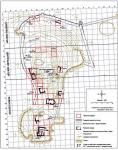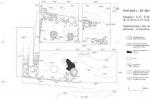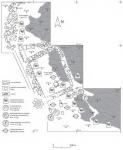Summary (English)
EXPLORATIONS ON KOZI GRAMADI PEAK (Ivan Hristov – ivchristov70@abv.bg) A Thracian temple, 40 sq. m in size, was explored in the Southern Sector of the peak. Its walls were preserved up to 1.80 m in height, built of dry roughly-cut stones. The entrance was 2 m wide, located on the eastern side of the building. Thracian sherds from the 8th – 6th centuries BC were found. During the 4th century BC the roof of the building was covered with tegulae and imbrices. A sector from the fortification wall, 15 m long, was discovered in the western foot of the Southern Sector. The wall was 2 m wide, built of ashlars, with buttresses. The finds comprised sherds, including from Greek amphorae and black-gloss pottery of the 5th century BC, tegulae, terracotta dices, spindle whorls and a loom weight, bronze coins of the 4th century BC. A lead sling shot with the name of Anaksandros, an officer of Philip of Macedon, a bronze coin of the Odrysian King Teres II and bronze coins of Philip of Macedon indicated the Macedonian conquest of the fortress in the middle of the 4th century BC. The church of the end of the 4th – beginning of the 5th century AD was thoroughly explored. It was 9 m by 4.50 m in size. During the 4th century AD, three buildings were constructed to the northwest of the church, with small votive reliefs reused in their walls. The finds from the explorations in the Central Sector around the top of the peak comprised 160 intact and fragmentary small marble votive reliefs of Zeus and Hera and over 200 fragments dated mainly from the middle of the 3rd century AD to the reign of Constantine the Great, four hoards with over 220 coins (Philip of Macedon, Alexander the Great, hemidrachms of the Thracian Chersonesos, a drachm of Istros, silver and bronze coins of the Odrysian Kings Kotys I and Teres II, Roman and Late Antique coins form the 2nd to the beginning of the 5th centuries AD), pottery and terracotta lamps. An open rock sanctuary of Zeus and Hera existed on the top of the peak. An entrance of the fortress was documented in the Northern Sector.
- Ivan Hristov - National Museum of History
Director
Team
Research Body
- National Museum of History






![Download [PDF]](/excavation/skins/fasti/images/results/download_sml.png)

